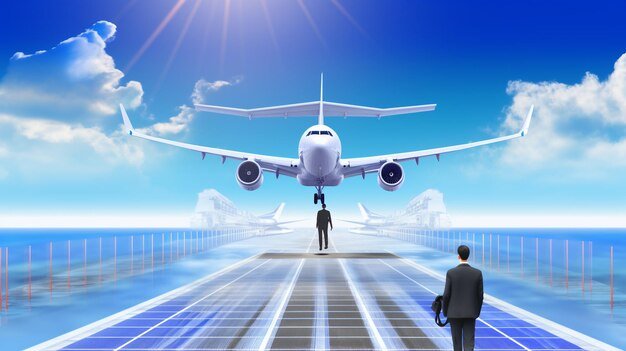Jet lag and fatigue are two of the most common challenges pilots face due to their irregular schedules, long flight hours, and frequent travel across multiple time zones. As essential as rest is for pilots to ensure safety and efficiency in their roles, managing these physical and mental challenges is a critical part of their training and operational responsibilities. In this article, we’ll dive into the strategies pilots use to manage jet lag and fatigue, and how they ensure they remain fit for duty.
1. Understanding Jet Lag and Fatigue
Jet lag occurs when a pilot travels across multiple time zones and their body’s internal clock (circadian rhythm) struggles to align with the new local time. Symptoms include tiredness, trouble sleeping, difficulty concentrating, and digestive issues. Fatigue, on the other hand, is an overall sense of tiredness or exhaustion, which can be exacerbated by long hours, irregular sleep schedules, and the mental demands of flying.
Both jet lag and fatigue can affect a pilot’s performance, potentially impairing their decision-making, reaction times, and ability to stay alert. This is why pilots must have strategies in place to combat these issues effectively.
2. Pre-Flight Preparation and Sleep Management
Pilots typically begin managing jet lag and fatigue well before they step on the plane. Adequate rest and sleep management play a significant role in minimizing fatigue during long-haul flights.
- Adjusting Sleep Patterns in Advance: Pilots may gradually adjust their sleep schedule to align with the time zone of their destination. If flying to a location with a significant time difference, they might go to bed earlier or later in the days leading up to the flight, helping their body adjust to the new time zone.
- Sleep Hygiene: Prior to long flights, pilots focus on ensuring they are well-rested. This involves creating a conducive sleep environment by minimizing light, avoiding stimulants like caffeine and alcohol, and using sleep aids such as earplugs or eye masks when needed.
- Napping During Layovers: During layovers, pilots often take short naps to recharge before their next flight. These naps can be crucial for maintaining energy levels and preventing sleep deprivation during long stretches of work.
3. Strategic Light Exposure
One of the most effective methods to manage jet lag is through the strategic exposure to light. Light exposure helps reset the body’s internal clock and realigns circadian rhythms with the new time zone.
- Morning and Evening Light: Pilots may expose themselves to sunlight at specific times to help regulate their body’s sleep-wake cycle. For instance, exposure to morning sunlight helps adjust to earlier time zones, while exposure to evening light helps adapt to later time zones.

- Avoiding Blue Light: Blue light, which is emitted by screens on smartphones and laptops, can disrupt sleep patterns. Pilots are trained to minimize blue light exposure in the hours leading up to their designated sleep time, using apps or blue light-blocking glasses to avoid interference with their circadian rhythm.
4. Nutrition and Hydration
Proper nutrition and hydration are vital components of managing fatigue and preventing jet lag. Pilots follow healthy eating habits and stay hydrated throughout their journey to maintain their energy levels.
- Hydration: Dehydration is a major contributor to fatigue, especially during long flights, where the dry air in the cabin can exacerbate tiredness. Pilots are encouraged to drink plenty of water during flights and avoid excessive caffeine or alcohol, which can lead to dehydration.
- Nutritious Meals: Eating nutrient-dense foods helps maintain energy levels and cognitive function. Pilots typically eat light, balanced meals during flights, avoiding heavy or greasy foods that can make them feel sluggish. They also snack on healthy options like fruits, nuts, and protein bars.
- Avoiding Caffeine and Alcohol Before Sleep: While caffeine may help keep a pilot alert, it’s generally avoided before sleep, as it can disrupt rest. Similarly, alcohol, although it may initially seem relaxing, can disturb sleep cycles and reduce sleep quality.
5. Exercise and Movement
Regular physical activity helps combat the effects of fatigue and jet lag. Long periods of sitting can lead to stiffness and reduced circulation, which exacerbates tiredness and discomfort. Pilots often incorporate exercises and movement into their routine to stay active and alert.
- Stretching and Walking: During long flights, pilots take breaks to stretch, walk around the cabin, and perform light exercises. This improves circulation and helps reduce the risk of deep vein thrombosis (DVT) caused by prolonged sitting.
- Incorporating Exercise During Layovers: Pilots often use layovers as an opportunity to exercise and combat fatigue. Simple activities like walking, swimming, or even yoga can help improve circulation and reset their bodies after long flights.
6. Crew Rest and Rotation
On long-haul flights, pilots work in shifts to prevent fatigue from setting in. Crew members are required to take rest periods during the flight, which are typically scheduled so that there is always a rested pilot in the cockpit.
- Flight Crew Rotation: On flights lasting several hours or more, pilots will rotate with other qualified crew members. This allows each pilot to rest during the flight and remain alert when it’s their turn to operate the aircraft.
- Crew Rest Areas: Long-haul aircraft are equipped with designated rest areas for flight crews, where they can sleep in a private, quiet environment during their off-duty periods. These spaces are designed to be comfortable and conducive to short periods of high-quality sleep.
7. Mindfulness and Stress Management
Mental fatigue is just as important as physical fatigue when it comes to flight safety. Pilots need to be mentally alert, focused, and calm to make critical decisions in high-pressure situations. Mindfulness and stress management techniques help pilots maintain mental clarity during flights.
- Breathing Exercises: Pilots often practice deep breathing exercises to manage stress and anxiety before and during flights. Controlled breathing helps lower stress levels and improves focus and concentration.
- Meditation and Relaxation: Some pilots engage in meditation practices or listen to calming music during their downtime to relax and de-stress. Mental relaxation techniques help reduce overall fatigue and promote a calm and alert state of mind during flight.
8. Monitoring Fatigue Levels and Reporting
Pilots are trained to recognize the signs of fatigue and are encouraged to report when they feel too tired to operate an aircraft safely. Fatigue management is taken seriously, and pilots are required to follow strict rest regulations and protocols.
- Flight Duty Regulations: The Federal Aviation Administration (FAA) and other governing bodies have set regulations on flight hours to ensure pilots have sufficient rest. Pilots are limited in the number of hours they can fly and must have mandatory rest periods between shifts to prevent fatigue from affecting their performance.
- Fatigue Reporting Systems: Pilots have access to systems where they can report fatigue or any concerns regarding their ability to operate safely. This helps airlines maintain a safety culture, ensuring that fatigued pilots are replaced by well-rested crew members.
Conclusion
Jet lag and fatigue are challenges pilots regularly face, but they are equipped with a variety of tools, strategies, and technologies to manage these issues. From adjusting sleep schedules and staying hydrated to taking rest during layovers and using mental relaxation techniques, pilots are trained to stay alert, focused, and healthy. By following these practices, they can continue to perform their critical roles while ensuring the safety of passengers and crew alike.









